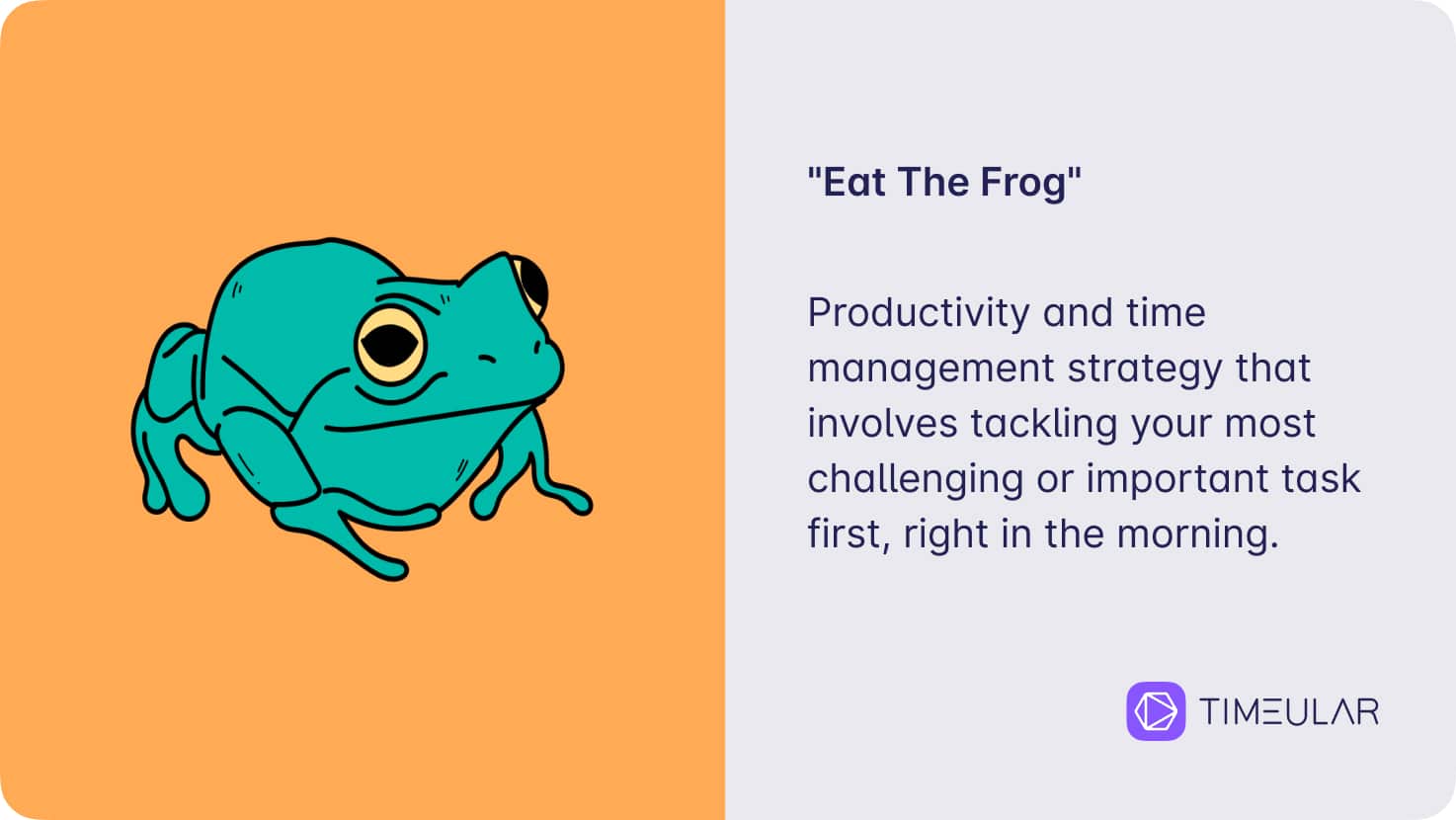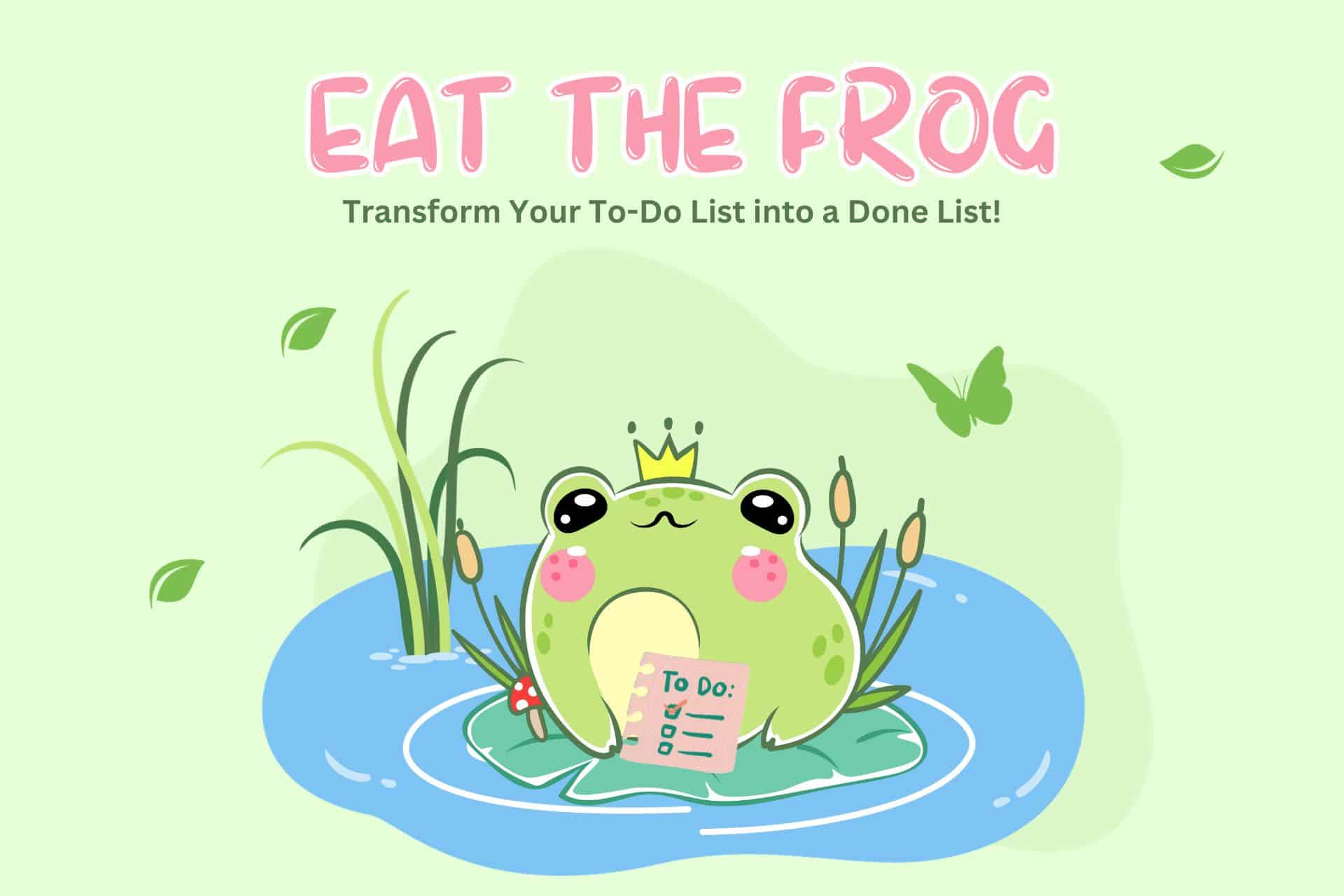Eat the Frog Technique: A Fresh Approach to Time Management Beyond Pomodoro
Researcher in mindfulness and its effects on productivity.

Researcher in mindfulness and its effects on productivity.

The "Eat the Frog" technique draws its name from a quote by Mark Twain. He famously said, "Eat a live frog first thing in the morning and nothing worse will happen to you the rest of the day."
Productivity consultant Brian Tracy popularized this concept in his book "Eat That Frog!: 21 Great Ways to Stop Procrastinating and Get More Done in Less Time." The core idea is to tackle your most challenging task, your "frog," right at the start of your day. This task is typically the most important and impactful one, but also the one you're most likely to procrastinate on.
While both Eat the Frog and the Pomodoro Technique aim to boost productivity, they differ significantly in their approach. The Pomodoro Technique, developed by Francesco Cirillo, involves working in 25-minute focused intervals followed by short breaks. You can learn more about how to implement this technique in our detailed guide, "Understanding The Pomodoro Technique: Simple Steps To Boost Your Focus."
Eat the Frog, on the other hand, focuses on prioritizing and completing the most daunting task first, regardless of how long it takes. Pomodoro is about time management, while Eat the Frog is about task management and prioritization.

By tackling the most challenging task first, you leverage your peak energy and focus levels. This is often in the morning for many people.
Research from behavioral scientist Dan Ariely supports this. We tend to have peak energy, focus, and motivation about two hours after waking up. This approach ensures that your most important work gets done when you're at your best, leading to higher quality output and a more productive day.
Procrastination often stems from the fear or avoidance of difficult tasks. The "eat the frog" approach helps you build better habits to stop procrastinating.
By confronting your "frog" head-on, you eliminate the looming dread that can cause anxiety and hinder your progress. Completing the hardest task early provides a sense of accomplishment and relief, making the rest of the day feel more manageable.
Successfully eating your "frog" creates a powerful sense of achievement that sets a positive tone for the day. This accomplishment fuels your motivation and builds momentum.
Each completed task, especially the most challenging one, propels you forward, making it easier to tackle subsequent tasks with confidence and enthusiasm. It is a win-win.

"Frogs" are significant tasks that have a major positive impact on your goals. They are often complex, time-consuming, and may require substantial effort.
They are usually the tasks you are tempted to delay. To identify your "frogs," consider tasks that are crucial for your long-term objectives, have tight deadlines, or could significantly impact your team's progress.
Before starting your day, create a to-do list. Identify the one to three most important tasks that align with your goals.
These are your potential "frogs." Organize them in order of importance and difficulty. Asana provides a guide on how to manage and prioritize tasks.
Commit to working on your biggest "frog" as soon as you start your day. Avoid distractions like emails or meetings until this task is complete.
This requires discipline but pays off significantly in the long run. This is especially true if you are a night owl, as discussed in "Embrace Your Inner Night Owl: Crafting the Perfect Work Schedule in Tech."
Breaking down your "frog" into smaller, manageable steps can help maintain motivation. Celebrate each milestone you achieve.
This keeps you engaged and motivated. It provides a sense of progress that encourages you to keep going until the entire task is completed.

Both Eat the Frog and Pomodoro aim to improve productivity but use different strategies. Eat the Frog prioritizes tackling the most challenging task first, while Pomodoro uses timed intervals for focused work.
Eat the Frog is about task prioritization. Pomodoro is about structured work periods.
| Feature | Eat the Frog | Pomodoro Technique |
|---|---|---|
| Focus | Task prioritization | Time management |
| Structure | Complete the hardest task first | Work in 25-minute intervals with short breaks |
| Duration | Varies depending on the task | Fixed 25-minute work periods |
| Breaks | Taken after completing the "frog" | Regular 5-minute breaks |
| Best For | High-impact, complex tasks | Maintaining focus over extended periods |
| Flexibility | Less structured, more task-oriented | Highly structured, time-based |
| Goal | Accomplish the most important task daily | Enhance concentration and reduce fatigue |
| Application | Ideal for prioritizing and tackling daunting tasks | Suitable for tasks requiring sustained attention |
Eat the Frog is ideal for large, daunting projects that require significant effort and have a high impact. Pomodoro is better suited for tasks that benefit from sustained focus over shorter periods, such as writing or studying.
For instance, if you are preparing for a major presentation, Eat the Frog helps you prioritize working on it first. If you are coding or writing a report, Pomodoro's structured intervals can enhance your concentration.
Incorporating Eat the Frog into your daily routine can transform your productivity. Start each day by identifying your "frog" and committing to tackling it before anything else.
This might mean waking up earlier. It may involve blocking out specific time in your calendar dedicated solely to this task.
Beyond Eat the Frog, several other techniques can help manage your time effectively. Time blocking involves scheduling specific blocks of time for particular tasks, ensuring dedicated focus.
The Eisenhower Matrix helps prioritize tasks based on urgency and importance. The 80/20 rule, or Pareto Principle, suggests that 80% of your results come from 20% of your efforts. Identifying and focusing on that critical 20% can maximize your productivity.

Finding the right time management method is a personal journey. What works for one person may not work for another.
Experiment with different techniques, such as combining Eat the Frog with time blocking or the Eisenhower Matrix. This can help you discover the most effective approach for your unique needs and work style.
Ultimately, the goal of any time management technique is to help you achieve more while reducing stress. Eat the Frog offers a powerful way to prioritize and tackle your most important tasks.
By making it a daily habit, you can enhance your productivity, reduce procrastination, and build momentum toward your goals. Remember, the key is consistency and finding what works best for you.
Key Takeaways:
— in Mindfulness
— in Productivity
— in Productivity
— in Mindfulness
— in Productivity